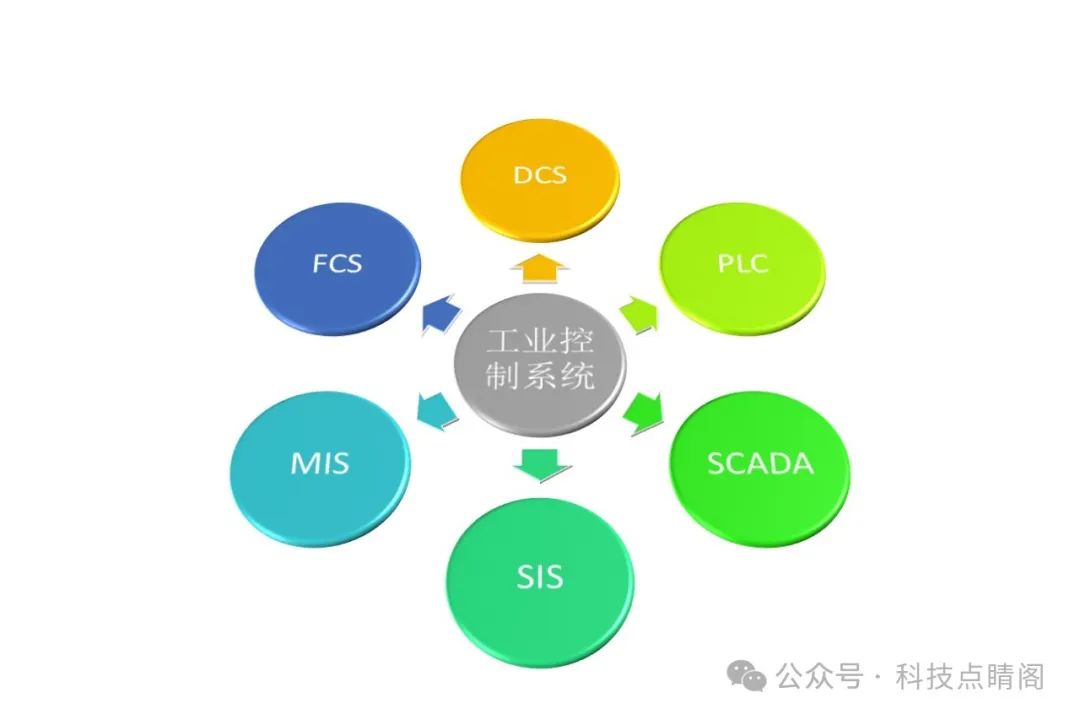Industrial Control Systems (ICS) are automation control systems used in industrial production, manufacturing processes, and facility management, designed to achieve real-time monitoring, control, and optimization of production processes.ICS are core components for achieving automation, improving production efficiency, ensuring safety, and reducing manual intervention. They are widely used in industries such as oil, chemicals, electricity, metallurgy, mining, pharmaceuticals, and food processing.

1, DCS (Distributed Control System)
DCS is a system for process control through distributed control units (controllers). Each control unit or node is responsible for a portion of the process control tasks, but the system works collaboratively to ensure the stability and optimization of the production process.
Features:
Distributed architecture: Multiple controllers are distributed in different locations, forming a unified system.
Process control: Particularly suitable for complex, continuous process control (such as chemical and power production).
Real-time capability: Strong real-time control ability, able to respond quickly to changes in the process.
Fault tolerance: Improves system reliability and stability through redundant design.
2, PLC (Programmable Logic Controller)
PLC is a computer controller used for industrial automation control, capable of controlling based on preset programs and logical instructions. It is mainly used to control single, discrete automation devices.
Features:
Suitable for discrete control: Control tasks are relatively simple, often used for controlling binary input/output, such as motor start/stop, robotic actions, etc.
Highly flexible: Users can write programs to adapt to different control needs.
Strong anti-interference capability: Adaptable to harsh industrial environments, resistant to high temperatures and electromagnetic interference.
Real-time control: Suitable for rapid response to industrial automation demands.
The boundaries between DCS and PLC are becoming increasingly blurred.
3, SCADA (Supervisory Control and Data Acquisition)
SCADA systems are integrated automation systems used to monitor and control geographically distributed industrial processes.SCADA primarily collects data from and remotely controls lower-level devices through a supervisory computer system.
Features:
Data collection and remote control: Collects field data through sensors, controllers, etc., and enables remote monitoring and control.
Large-scale distributed systems: Suitable for widely distributed industries such as electricity, water, oil and gas, and transportation.
Data analysis and alarms: Real-time monitoring of equipment status, alarms, and historical data analysis help prevent failures in advance.
Visual interface: Graphical interfaces help operators monitor production processes and equipment operating status.
4, SIS (Supervisory Information System in Plant Level)
SIS systems act as middleware between lower-level control systems (such as DCS) and management information systems (MIS), serving real-time management and monitoring of production processes for comprehensive optimization of the entire plant. They are applied in industrial fields such as power plants for production process monitoring and management.
5, FCS (Field Control System)
FCS is a system specifically designed for controlling field devices, typically deployed on the production site, directly controlling sensors, actuators, valves, and other equipment.
Features:
Strong real-time capability: Directly connected to field devices, with very short response times.
Centralized management: Typically collaborates with DCS to optimize processes through field control.
Simplified control: Suitable for processes requiring high precision and reliability.
6, MIS (Management Information System)
MIS is primarily used for enterprise management decision support, integrating various business data to provide real-time or periodic reports and decision support tools for management.
Features:
Data integration and analysis: Gathers data from production, sales, finance, and other areas to assist management in business decision-making.
Reporting and decision support: Generates various analytical reports in real-time, such as production efficiency, cost control, inventory management, etc.
Business optimization: Improves operational efficiency and effectiveness through data-driven analysis.
7, Differences
Functionally, DCS and PLC are both used in control systems, but DCS is more suitable for process control, while PLC is more used for discrete control, although the distinction is now minimal. SCADA focuses on monitoring and data acquisition, SIS emphasizes production process monitoring, MIS is aimed at enterprise management decision-making, and FCS specializes in field control.
In terms of application areas, DCS, PLC, and FCS are mainly used in automation control and industrial processes, SCADA is suitable for large-scale distributed systems, SIS is primarily used for monitoring and management, while MIS is focused on decision support for company management.
In terms of complexity, DCS and SCADA are more suitable for complex systems, SIS requires high safety standards, while PLC is relatively simple, mainly used for single device control.
Copyright Notice: Reproduction is prohibited! If there is any infringement, it will be deleted immediately.
Summarizing is not easy, everyone please support! If the summary is incomplete or incorrect, please be tolerant!